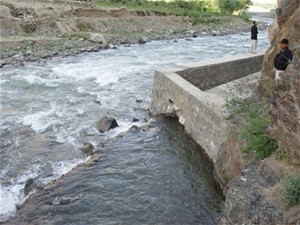
The rehabilitated Karaste Canal channels water to low-lying farms and sloping and upland fields in Tagab District, spurring agricultural production in this cluster of villages along the Tagab River. In response, the provincial Department of Agriculture ha
Johannes Oosterkamp
After almost 30 years of lying idle, USAID revives a flawed irrigation canal to water 200 hectares of parched but fertile fields in Tagab District.
24 JUNE 2008 | BADAKSHAN, AFGHANISTAN
In the sweeping valley of Karaste in the Tagab District of Badakshan province, a cluster of villages dot the banks of the Tagab River. These farming communities, comprised of about 3,000 families, have long been hoping to have a reliable water supply to make their land more productive. In the late 1970s, a small canal was built in this area but due to a flaw in design it functioned for only one season. The canal was abandoned and eventually the intake and upstream portion of the canal were totally destroyed by flashfloods and lack of maintenance.
When the USAID Alternative Development Program/North came to Badakhshan in 2005, the Karaste villagers expressed hope to revive their canal. The shura (village council) and village elders petitioned USAID to rehabilitate the irrigation facility. USAID responded favorably to their request.
Rehabilitation of the Karaste Canal involved heavy masonry work to make the structure withstand the strong flashfloods that often occur after snowmelt and heavy rains. The canal’s water intake was widened and increased to harness the abundant water flowing from the Tagab River. The repaired part of the canal stretched 380 meters long. When the project was completed in June 2007, up to 200 hectares of orchards, wheat fields, and vegetable farms were provided with a reliable supply of water from the Tagab River.
A year after its completion – and 30 years after the first canal in the same area was constructed – the farming families of Karaste are now seeing lush wheat and rice fields, flourishing orchards, and vegetable farms where there used to be just a wide expanse of prime but underutilized agricultural land. For the first time, harvests are abundant, not only in the farmlands along the banks of the river but also further up the valley slopes.
Makhdom Shojauddin, the deputy of the Karaste Shura, said, “For a long time this canal was useless, but USAID granted our request. These days, farmers are cultivating much more than they ever did before. You won’t see any poppies around because it’s much more profitable growing wheat and vegetables. We greatly appreciate USAID for helping us farmers in Karaste to make our land produce more.”
Across the major agricultural districts of Badakhshan, USAID has undertaken 23 projects to improve existing irrigation facilities or construct new ones where it was crucial for sparking agricultural activities. The Alternative Development Program/North aims to support licit agricultural economy in this remote and hard-to-reach northeast province, once considered to be one of the big producers of opium poppy in Afghanistan.







Comment
Make a general inquiry or suggest an improvement.